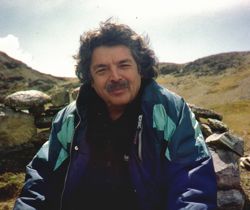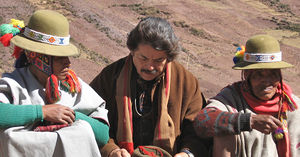One overriding factor to take into account when contemplating the Andean Cosmovision (view of the basic nature of the Cosmos) is that it is fundamentally different than that of Western* culture. This means that we can’t simply force their ideas into our own conceptual categories. The temptation to do so, however, is strong and rather automatic for we are accustomed to making sense of new things by relating them to what we already know.
We in the West essentially have two ways of viewing the basic nature of reality; through the lens of science or through the lens of (Western) religion. While these two approaches have some important differences they both arose within our culture and were built upon the same philosophical foundation. The indigenous Andean culture, however, does not share that foundation. Neither science nor religion have a counterpart in the Andean Cosmovision, and what they have (for which we have no corresponding terms) has no counterpart in our Cosmovision (or we would have corresponding terms).
Imagine, if you will, a view of reality that was not influenced by the Bible (where God as the creator stands outside of the creation and who made humans, alone of all the species, in His own image). It was not influenced by the classic Greek philosophers who emphasized the intellect as the highest form of knowledge, nor was it shaped by Descartes (the ‘Father of Modern Philosophy’) who proposed that reality consists of two separate realms, a transcendent realm of spirit and mind and a physical realm of mindless energy and matter. If we wish to explore the Andean Cosmovision we need to let go of our normal way of thinking about the world and approach it with room for it to be something brand new, we need to be a more accommodating (letting new information change how we view the world) and less assimilating (making new information fit how we already view the world).
The Andean Cosmovision is mystical in its essence. Mysticism is the belief that words (including beliefs) are, at best, signposts or blueprints for how to connect directly with the sacred underlying nature of reality, and that it is that connection with the Sacred–not the words or beliefs–that is of fundamental importance. The Andean Cosmovision is not primarily about their beliefs, it is about the experience of reality that becomes possible with these beliefs, it is about the relationship with Nature and with the Cosmos that becomes possible with these beliefs. Neighboring villages in Peru differ somewhat in what they believe, as do paqos (mystics/shamans) within the same village, but those differences are irrelevant to being a paqo, for what matters is what they can accomplish through those beliefs. What they can accomplish arises from the loving and mutually supportive relationship with Nature and the Cosmos that is made possible and nourished by their Cosmovision.
Here is my representation of the Andean Cosmovision. Imagine the Cosmos as consisting solely of filaments of energy organized into a tremendous three dimensional web. Where the filaments come together to form a bundle or a node is what we experience as an object. You are such a node, as am I, as is my coffee mug sitting here by my keyboard as I type. There are some important consequences of this world-view:
- Everything in the universe is part of this web of filaments and so ultimately everything in the universe is connected to everything else. This means that a flow of information or energy or influence can exist between ourselves and anything else, including other people, the stars, the river, the wind, and the rest of the Cosmos.
- While these bundles of filaments, these nodes in the web of filaments, are distinct from each other they are really inseparable parts of the larger, unified whole that is the Cosmos. Perceiving the world as consisting of isolated objects and experiencing our consciousness as limited to just our own being is but one way of approaching the Cosmos, the way most supported by our Western Cosmovision. The ability to actually experience the Cosmos as an undifferentiated whole is a defining goal of every mystical approach of which I am familiar, including that of the Andean Cosmovision.
- While the nodes that constitute humans may differ in the way the are organized from the nodes that make up a stone or a tree, we are all just bundles of filaments of energy and the differences between us is less in the Andean perspective than in the perspective of Western culture (where the gap between being a stone and being human is immense indeed). The diminishing of the difference between types of objects in the Andean Cosmovision is tied at least partially to their view that everything is conscious.
In the Andean Cosmovision consciousness is an inherent attribute of the filaments, rather than being a byproduct of an advanced nervous system . The idea that stars, trees, and even stones are conscious is so far from how my discipline of psychology views consciousness as to make the idea seem ludicrous from that perspective. Consciousness, however, from the perspective of the intellect, is and must remain the ultimate mystery of the universe, for consciousness, while it can be experienced, cannot be understood. The intellect trying to understand consciousness is like a knife trying to cut its own edge. Consciousness needs to be separated from all of our concepts about it, including what we think about thinking and about being self-aware and so on. Rather than consciousness being something of dubious reality because it is so unapproachable intellectually, it is instead the most real thing in the universe, for consciousness is that out of which our ability to think emerges. But I digress.
Of all the nodes of filaments in our neighborhood of the Cosmos perhaps the most important one is the Pachamama, the great bundle of filaments, the incredible spiritual Being, who is our Cosmic mother the planet earth. While I call the Pachamama a ‘spiritual’ being she is not a transcendent spirit residing in the large rock we call earth. Western culture essentially only gives us two options for viewing ‘spirit’, that spirit is transcendent (e.g. a soul that descends from heaven to inhabit the physical realm) or that ‘spirit’ does not exist. The Andes provide a third option, that the planet itself is a great spiritual being, that the sacred is not separate from the filaments but is immanent in them. The Pachamama is not the great spiritual being who resides in the earth, she is the great spiritual being who is the earth.
Other important Beings (nodes in the web of filaments) include the Apus. The Apus are the great beings who are the majestic mountain peaks. While the Apus are physically part of the Pachamama they are also Beings themselves. This is a common feature of the Andean Cosmovision. The Cosmos is one tremendous web of filaments but it does have places where the filaments come together to form a node. The Pachamama is but a node in the whole web, yet she is herself; the Apus are but part of the node that is the Pachamama but they are themselves as well; a cultivated field (called a ‘chakra’) is but part of the Pachamama, but before planting the field the villagers communicate with and make offerings of gratitude to the chakra (the daughter of the Pachamama) as well as to the Pachamama herself.
The further we go into details about the Andean Cosmovision the more variations we will find across individuals, villages, and regions of the Andes. The version I have given is my personal, inevitably Western-flavored, account but I have found that it provides good support for my exploration of this Cosmovision and I offer it to you in the hope that it may serve you as well. Before drawing to a close I want to emphasize again that the beliefs themselves are of little importance, what is important is the loving and mutually supportive relationship with Nature and the Cosmos that becomes possible within this Cosmovision, within this relationship some beautiful and magical things can occur that cannot be understood by the intellect.
The Andean Cosmovision opens us up to a whole new way of understanding reality, a whole new realm for us to explore. This blog is essentially a guidebook based upon my experiences. Treat it as you would any guidebook, understanding that while it is meant to contain useful information that my tastes, evaluations, and interests may differ in some cases from your own, and that a guidebook is no substitute for actually going there.
*The distinction of Western (Occidental) vs. Eastern (Oriental) philosophy doesn’t really make sense in this context. I need, however, a term to refer to the view of reality that arose in Europe and that served as the foundation of modern, industrial, technological society. For simplicity of expression I simply call it ‘Western’ society.
Share... 









